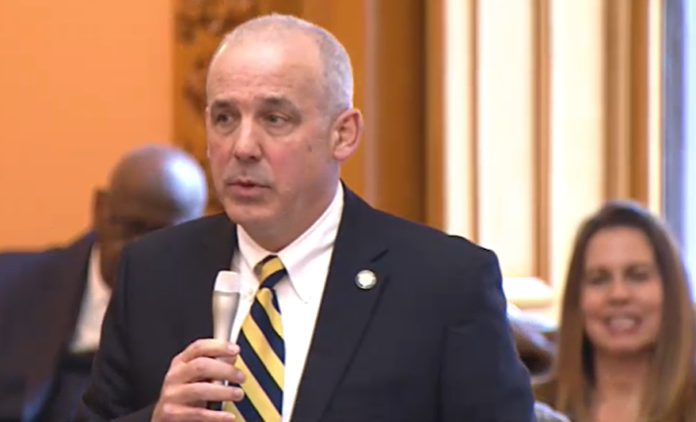Lawmakers from both parties had been hopeful Ohio would take a big step forward this year to invest in broadband internet expansion throughout the state.
Leaders in the Ohio Senate think otherwise. While their counterparts in the Ohio House of Representatives want to allocate millions of dollars for internet expansion projects, Republican state senators want to remove this funding to help pay for several proposed tax cuts.
Senate President Matt Huffman, R-Lima, and Finance Chairman Matt Dolan, R-Chagrin Falls, outlined on Tuesday their chamber’s proposed state budget for the next two fiscal years. Highlights of this suggested budget include changes to Ohio’s school funding model and more than $1 billion in new tax cuts.
Included is a 5% income tax cut for Ohio workers as well as other tax cuts related to business development that Huffman said is meant to spur job growth. The Ohio House of Representatives’ budget, passed in April, proposed a 2% income tax cut.
To pay for these tax cuts, Senate leaders want to reduce funding for the Department of Job and Family Services as well as the Department of Medicaid. Dolan characterized these as administrative cuts that will have no impact to public services.

Another way to pay for the tax cuts is the elimination of funding toward internet expansion projects.
Internet access has been a priority for both Democratic and Republican officials in recent years. Gov. Mike DeWine proposed $250 million in grant funding in his own budget proposal earlier in 2021.
The House’s budget bill included $190 million for this purpose.
Outside of budget negotiations, both chambers recently approved House Bill 2 to create the Ohio Residential Broadband Expansion Grant Program. DeWine signed the bill into law in May; it allocates an initial $20 million of funding.
The hope was to pump more money into this grant program via the state budget. The Senate proposes no additional money for broadband expansion, removing the House’s $190 million in its entirety.
Huffman acknowledged there are rural and urban areas of the state without reliable internet access, but still expressed hesitation over an increase in spending to fix the problem. Experts believe an estimated 1 million Ohioans do not have access to high-speed internet at home.
“I think people are anxious to spend money on something that everybody thinks is a good idea,” Huffman told reporters on Tuesday. “I think it’s a bad idea to just start spending without a plan.”
The Ohio Residential Broadband Expansion Grant Program created by HB 2 does set forth a detailed way to use state funding toward infrastructure projects.
Certain areas of the state — such as hilly areas of Appalachian Ohio — lack internet access because the challenging terrain discourages private companies from wanting to pursue projects there.
The goal of the grant program is to fill in that “cost gap.” The state funding would help entice companies to invest in expansion projects in otherwise hard-to-reach areas.
State Reps. Rick Carfagna, R-Genoa Twp., and Brian Stewart, R-Ashville, were the two main sponsors of HB 2 and spent the early months of 2021 highlighting the benefits of internet access for business, health and educational purposes.
“High-speed internet is the great social equalizer of our time,” Carfagna has often said.
In a provided statement, the two lawmakers expressed hope their fellow Republicans in the other chamber would reconsider.
“Ohio now has a bipartisan strategy in state law to address this issue,” Carfagna and Stewart noted, referring to HB 2. “It’s imperative we fund it in a meaningful way to achieve real results.”
They continued: “Lack of broadband access presently denies employment, education, healthcare, and commerce opportunities to at least one million Ohioans, and the broadband expansion grants proposed by the House and Governor’s Office are designed to free up hundreds of millions in private investment to aggressively combat these disparities … (we) look forward to hearing how they intend to accomplish House Bill 2’s vision of facilitating the expansion of high-speed internet to unserved households across Ohio.”
Huffman said that providing internet access to all Ohioans does not necessarily mean they have the capability to use it.
He suggested this expansion would not be of help to residents who are not tech savvy.
“(S)imply providing broadband services does not mean that people who may be able to access that will or can access that,” Huffman said. “They still have to have a piece of equipment of some kind — a computer, iPad, whatever it may be — they have to know how to use it. They have to know what happens when it doesn’t work. And for people like me, I don’t know what happens when the thing doesn’t work, I have to ask somebody, and I assume a lot of other Ohioans are just like that.”
The American Rescue Plan signed into law by President Joe Biden in March does allocate $10 billion to states and other territories for broadband infrastructure. Huffman said these potential federal dollars did not influence his decision to take out the Ohio funding in the Senate’s proposed budget.
“I’m always a little bit suspicious that the federal government is going to do what it says it was going to do,” Huffman said. “Those dollars apparently are real. We’ll see about that. But we can’t pass a budget by June 30 hoping that the federal government is going to do what it said it is going to do.”
Once the Ohio Senate passes its version of the budget, lawmakers from the two chambers meet in what is known as a conference committee to hash out the differences between the respective budget bills. The legislature has until June 30 to finalize an agreed-upon budget before sending it to the governor for his signature.
***
Also from Ohio Capital Journal:
Commentary: 100 years after the Tulsa Race Massacre, lessons from my grandfather
By Gregory B. Fairchild, University of Virginia
When Viola Fletcher, 107, appeared before Congress in May 2021, she called for the nation to officially acknowledge the Tulsa race riot of 1921.
I know that place and year well. As is the case with Fletcher – who is one of the last living survivors of the massacre, which took place when she was 7 – the terror of the Tulsa race riot is something that has been with me for almost as long as I can remember. My grandfather, Robert Fairchild, told the story nearly a quarter-century ago to several newspapers.
Hearing about these experiences at the family table was troubling enough. Reading a newspaper account of your ancestors’ fleeing for their lives is a surreal pain. There’s recognition of your family’s terror, and relief in knowing your family survived what “60 Minutes” once called “one of the worst race massacres in American history.” READ MORE





